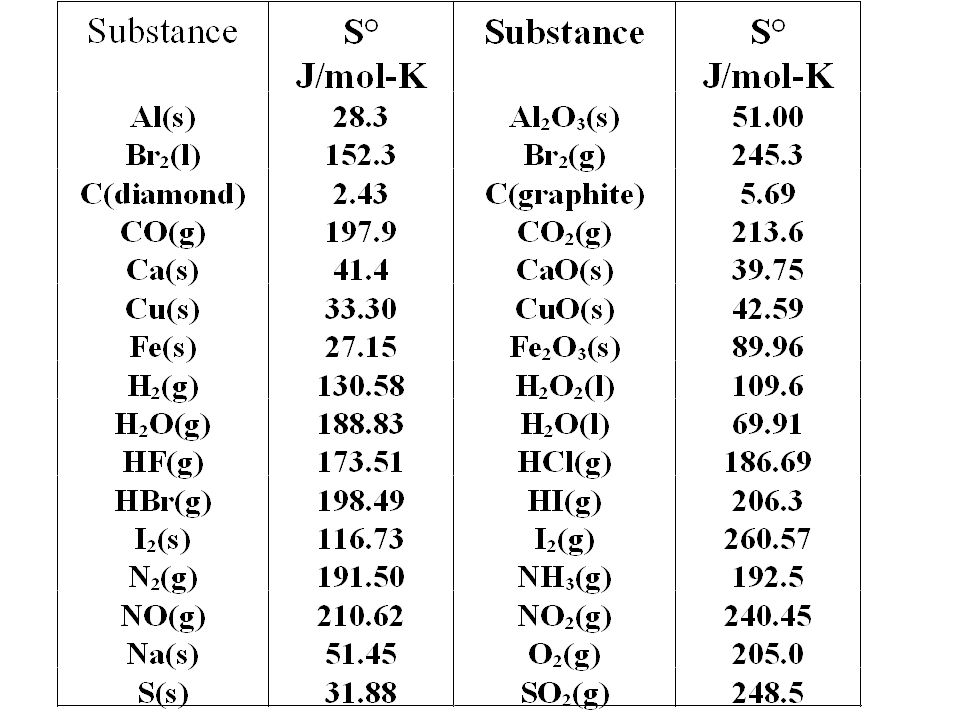

These estimates of Sm∘ of species for which ΔfGj∘ values are known make it possible to obtain ΔfHj∘ of species that can be used to calculate effects of temperature on standard transformed Gibbs energies of reactants and apparent equilibrium constants of enzyme-catalyzed reactions. Standard Enthalpies, Free Energies of Formation, and Standard Entropies at 298 K Substance: H 0 kJ mol-1 G 0 kJ mol-1 S 0 J mol-1 K-1 (COOH) 2 (aq) -818.3 -697.9 -(COOH) 2 (s) -826.8 -697.9 : 120 (NH 4) 2 SO 4 (s) -1179.3 -900.35 : 220.3: Ag (g) 289.2 : 250.4 : 172.892: Ag (s) 0.0 : 0.0 : 42. However, standard molar entropies Sm∘(298.15K,I=0) of species are of more interest because it may be possible to interpret their values and use them to estimate Sm∘ values for species for which ΔfHj∘ are unknown.

With the database BasicBiochemData2 and recent extensions, this can be done for about fifty reactants.

When the standard Gibbs energies of formation ΔfGj∘(298.15K,I=0) and standard enthalpies of formation ΔfHj∘(298.15K,I=0) of the species of a reactant are known, the standard entropies of formation ΔfSj∘(298.15K,I=0) can be calculated. The standard transformed entropy of reaction has received less attention, but it provides almost all of the pH dependence of the apparent equilibrium constant. The standard transformed enthalpy of reaction yields the heat of reaction. In a large system under even homogeneous external force, like the earth atmosphere under gravity, the intensive parameters should be studied locally having even in equilibrium different values in different places far from each other.The standard transformed Gibbs energy of reaction provides the criterion for spontaneous change and equilibrium for an enzyme-catalyzed reaction at specified temperature, pressure, and pH. G o is dependent on both the changes in enthalpy ( H o) and entropy (. Topics may include: Moles and molar mass. For example, while all the working fluid in a steam engine may have higher energy due to gravity while sitting on top of Mount Everest than it would at the bottom of the Mariana Trench, the gravitational potential energy term in the formula for the internal energy would usually be ignored because changes in gravitational potential within the engine during operation would be negligible. Mole is a standard measurement of amount which is used to measure the number. Predict whether the value of the standard entropy change, So, for the overall reaction is greater than 0. In thermodynamics, external forces, such as gravity, are typically disregarded when formulating expressions for potentials. Expressions for all other thermodynamic energy potentials are derivable via Legendre transforms from an expression for U. It is the energy of configuration of a given system of conservative forces and only has meaning with respect to a defined set of references. One main thermodynamic potential that has a physical interpretation is the internal energy U. Josiah Willard Gibbs in his papers used the term fundamental functions. The concept of thermodynamic potentials was introduced by Pierre Duhem in 1886. See alsoĪ thermodynamic potential is a scalar quantity used to represent the thermodynamic state of a system. Under identical conditions, it is greater for a heavier gas.

The standard molar entropy at pressure = P 0 These are often (but not necessarily) chosen to be the standard temperature and pressure. In chemistry, the standard molar entropy is the entropy content of one mole of pure substance at a standard state of pressure and any temperature of interest. equation 2.25 and Table 2.2 (This is in Chap 2, and a bigger one, also 2. Calculate the standard molar entropy at (a) 100☌ and (b) 500☌. Standard entropy content of one mole of a substance under a standard state 3.7 The standard molar entropy of NH 3 (g) is 192.45 J K 1 mol1 at 298 K, and its heat capacity is given by eqn 2.25 with the coefficients given in Table 2.2.


 0 kommentar(er)
0 kommentar(er)
